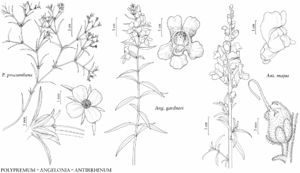Polypremum
Sp. Pl. 1: 111. 1753.
| Taxon | Illustrator ⠉ | |
|---|---|---|
 | Polypremum procumbens Angelonia gardneri Antirrhinum majus | Barbara Alongi Barbara Alongi Barbara Alongi |
Perennials or annuals, taprooted. Stems glabrous or sparsely scabrous along ridges. Cymes: bracts absent. Pedicels absent; bracteoles present. Flowers: calyx urceolate, lobes lanceolate; corolla white; stamens: filaments glabrous; stigma capitate. Seeds: wings absent. x = 10, 11.
Distribution
c, se United States, Mexico, West Indies, Central America, South America, in Pacific Islands, Australia
Discussion
Species 1.
Polypremum is sometimes confused with Loeflingia and Scleranthus of the Caryophyllaceae; the opposite, linear-acuminate leaves and axillary flowers are suggestive of those taxa. The relatively small, but conspicuous, white petals (absent or at most rudimentary in Loeflingia and Scleranthus) and the two-lobed capsule (three-valved capsule in Loeflingia, utricle in Scleranthus) distinguish Polypremum.
Selected References
None.